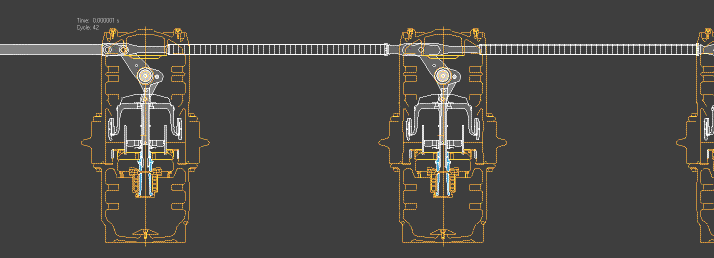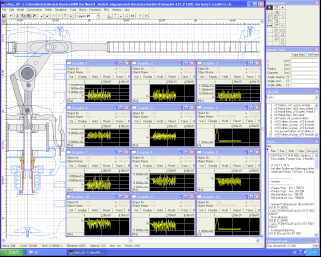


Collision control
The user determines an object's constraints and environmental conditions, including forces, frictions, disturbances, motors, gravitational effects, external forces, and so on. Within the boundaries of these conditions, the program automatically takes care of the rest during the running simulation. By default, all objects interact with each other. The collision control between the parts can however itself be controlled and changed in certain respects with so-called active and passive objects or with so-called bilateral rules, just to name a few methods
.
silux script
The software has its own simulation language (script language). This language is used for various tasks like
> Macro Language
> Command Language
> Control System Language
Resultate
SILUX can continually record every geometric and every physical variable of every part during a simulation (EXCEL Format). Films in the Vector- und Pixel formats (QuickTime movies) complement the material available for analysis
.
A universal multiple-object dynamic simulation program
SILUX belongs to the newest generation of simulation tools and allows the continuous dynamic simulation of any number of complex mechanisms or machines. The universal applicability of SILUX comes from the rigorous use of the method of finite differences on general problems as they appear in mechanical and instrument engineering
.
A comparison with biology
The individual objects in a SILUX model behave like single-celled organisms in biology. The object is the smallest living unit in SILUX. Each object obeys inner and outer physical conditions, but also has sensory abilities and a memory in order to recognize the immediate environment and to remember it. Each object goes through the simulation individually. Movements or collisions are reconciled bilaterally between the objects involved
.
Number of parts
The SILUX code allows you to simulate a theoretically unlimited number of objects with individual, complex borders. Simulations with 10,000 parts have already been carried out and each part can interact with every other part .
Features:
Pre-defined construction groups:
Springs
Dampers
Actuators
Motors
Cables
Gears
Fixpoints
Links
Sensors
Extras:
Disturbances
Friction
Gravitational fields
Programmable control systems
External forces or force fields
Special abilities :
Dynamic simulations of the following media in connection with a whole machine
:
Paper
Textiles
Threads
Wires
Cables
Chains
Script
language
:
Macro Language, Recording, Command Language, Control System Language
Structural analysis:
The individual objects in SILUX are rigid objects by default. Objects of special interest can be fitted with an inner grid structure however, which allows the elastic-plastic behavior of the object to be simulated along with everything else. This means the ALIEN-code is integrated into SILUX and can be activated for special tasks
.
(short description of the ALIEN-code)
silux-development:
The silux-code was developed by
Fritz Leibundgut, L&G Software.
